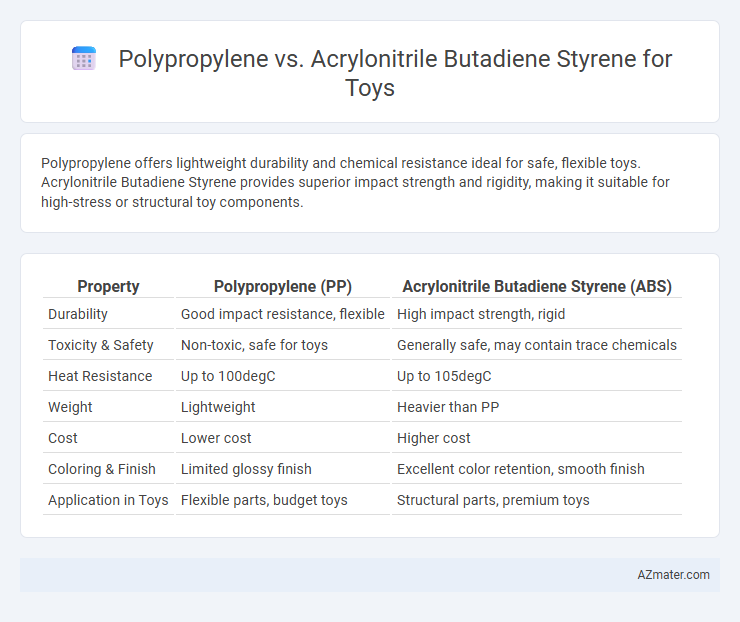Polypropylene offers lightweight durability and chemical resistance ideal for safe, flexible toys. Acrylonitrile Butadiene Styrene provides superior impact strength and rigidity, making it suitable for high-stress or structural toy components.
Table of Comparison
| Property | Polypropylene (PP) | Acrylonitrile Butadiene Styrene (ABS) |
|---|---|---|
| Durability | Good impact resistance, flexible | High impact strength, rigid |
| Toxicity & Safety | Non-toxic, safe for toys | Generally safe, may contain trace chemicals |
| Heat Resistance | Up to 100degC | Up to 105degC |
| Weight | Lightweight | Heavier than PP |
| Cost | Lower cost | Higher cost |
| Coloring & Finish | Limited glossy finish | Excellent color retention, smooth finish |
| Application in Toys | Flexible parts, budget toys | Structural parts, premium toys |
Introduction: Why Material Choice Matters in Toys
Choosing the right material for toys directly impacts safety, durability, and environmental sustainability. Polypropylene offers chemical resistance, lightweight properties, and recyclability, making it ideal for safe, long-lasting toys. Acrylonitrile Butadiene Styrene (ABS) provides superior impact resistance and a glossy finish, enhancing toy aesthetics and robustness during play.
Overview of Polypropylene (PP)
Polypropylene (PP) is a lightweight, durable thermoplastic widely used in toy manufacturing due to its excellent chemical resistance, impact strength, and low cost. It offers high fatigue resistance and can be easily molded into intricate shapes, making it ideal for producing safe and flexible toy components. Compared to Acrylonitrile Butadiene Styrene (ABS), PP provides superior moisture resistance and better recyclability, enhancing sustainability in the toy industry.
Overview of Acrylonitrile Butadiene Styrene (ABS)
Acrylonitrile Butadiene Styrene (ABS) is a durable thermoplastic known for its high impact resistance and toughness, commonly used in toy manufacturing for its strong structural integrity. ABS offers excellent surface quality and easy processing, enabling intricate designs and vibrant color finishes that appeal to consumers. Compared to polypropylene, ABS provides better rigidity and heat resistance, making it ideal for toys requiring durability and precision molding.
Mechanical Strength Comparison: PP vs ABS
Polypropylene (PP) offers moderate tensile strength and excellent impact resistance, making it suitable for flexible toy parts that require durability under bending or twisting. Acrylonitrile Butadiene Styrene (ABS) exhibits higher mechanical strength and rigidity, providing superior resistance to impact and deformation, ideal for structural toy components demanding toughness and dimensional stability. While PP provides better fatigue resistance, ABS outperforms in load-bearing applications due to its greater tensile strength and hardness.
Durability and Impact Resistance in Toys
Polypropylene (PP) offers excellent durability, with high fatigue resistance and chemical stability, making it ideal for toys that undergo repeated bending and rough handling. Acrylonitrile Butadiene Styrene (ABS) provides superior impact resistance and toughness due to its rubbery butadiene component, ensuring toys can withstand strong shocks and drops. While PP excels in flexibility and resistance to environmental stress, ABS is preferred for rigid, impact-resistant toys requiring enhanced structural strength.
Safety and Toxicity: Child-Friendly Considerations
Polypropylene (PP) is widely preferred for children's toys due to its non-toxic properties, high chemical resistance, and absence of harmful additives, making it safe for prolonged contact and potential mouthing. Acrylonitrile Butadiene Styrene (ABS) offers superior strength but may contain residual monomers and additives that raise concerns over toxicity and allergenic reactions in sensitive children. Safety regulations, such as ASTM F963 and EN 71, typically favor PP for toys intended for younger age groups due to its inertness and lower risk of leaching hazardous substances.
Color, Gloss, and Aesthetic Properties
Polypropylene offers a matte finish with moderate color vibrancy, making it suitable for toys requiring subtle hues and a soft touch. Acrylonitrile Butadiene Styrene (ABS) provides higher gloss and superior color retention, enhancing the visual appeal with vibrant, shiny surfaces ideal for toys demanding eye-catching aesthetics. ABS's ability to maintain bright, consistent colors under UV exposure makes it preferable for outdoor or high-wear toys where long-lasting appearance is critical.
Processing and Manufacturing Differences
Polypropylene (PP) offers ease of processing with excellent mold flow properties suitable for injection molding, allowing for faster cycle times and cost-effective production of complex toy shapes. Acrylonitrile Butadiene Styrene (ABS) requires higher molding temperatures and longer cooling times due to its toughness and impact resistance, resulting in slightly slower manufacturing but enhanced durability and surface finish quality. PP's chemical resistance and flexibility simplify recycling processes, while ABS provides superior heat resistance and structural strength, making both materials distinct choices depending on specific toy design requirements.
Cost Analysis: PP vs ABS for Toy Production
Polypropylene (PP) offers a lower material cost compared to Acrylonitrile Butadiene Styrene (ABS), making it a more budget-friendly option for toy production without compromising basic durability. ABS provides superior impact resistance and surface finish, which can justify its higher cost in toys requiring enhanced strength and aesthetic appeal. Manufacturers often balance raw material expenses and performance needs, with PP favored for cost-sensitive, lightweight toy applications while ABS suits premium, high-durability models.
Which Material is Better for Toys? Final Verdict
Polypropylene offers exceptional chemical resistance, flexibility, and lightweight properties, making it ideal for toys that require durability and safety, especially in items frequently handled by children. Acrylonitrile Butadiene Styrene (ABS) provides superior impact resistance and rigidity, ensuring toys maintain structural integrity under rough play but tends to be heavier and more expensive. For most toy applications, polypropylene's balance of safety, cost-effectiveness, and resilience makes it the better material, although ABS is preferred for high-impact, detailed designs requiring enhanced toughness.

Infographic: Polypropylene vs Acrylonitrile Butadiene Styrene for Toy
 azmater.com
azmater.com